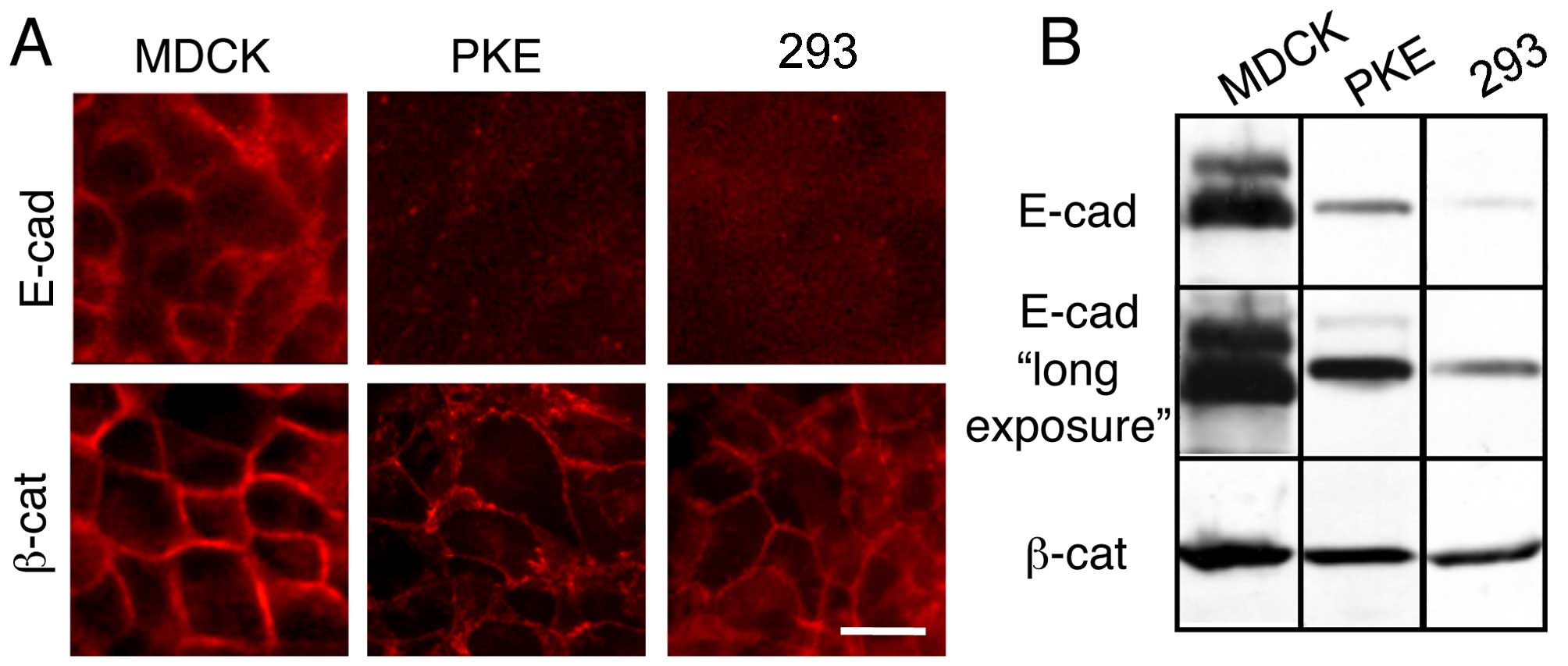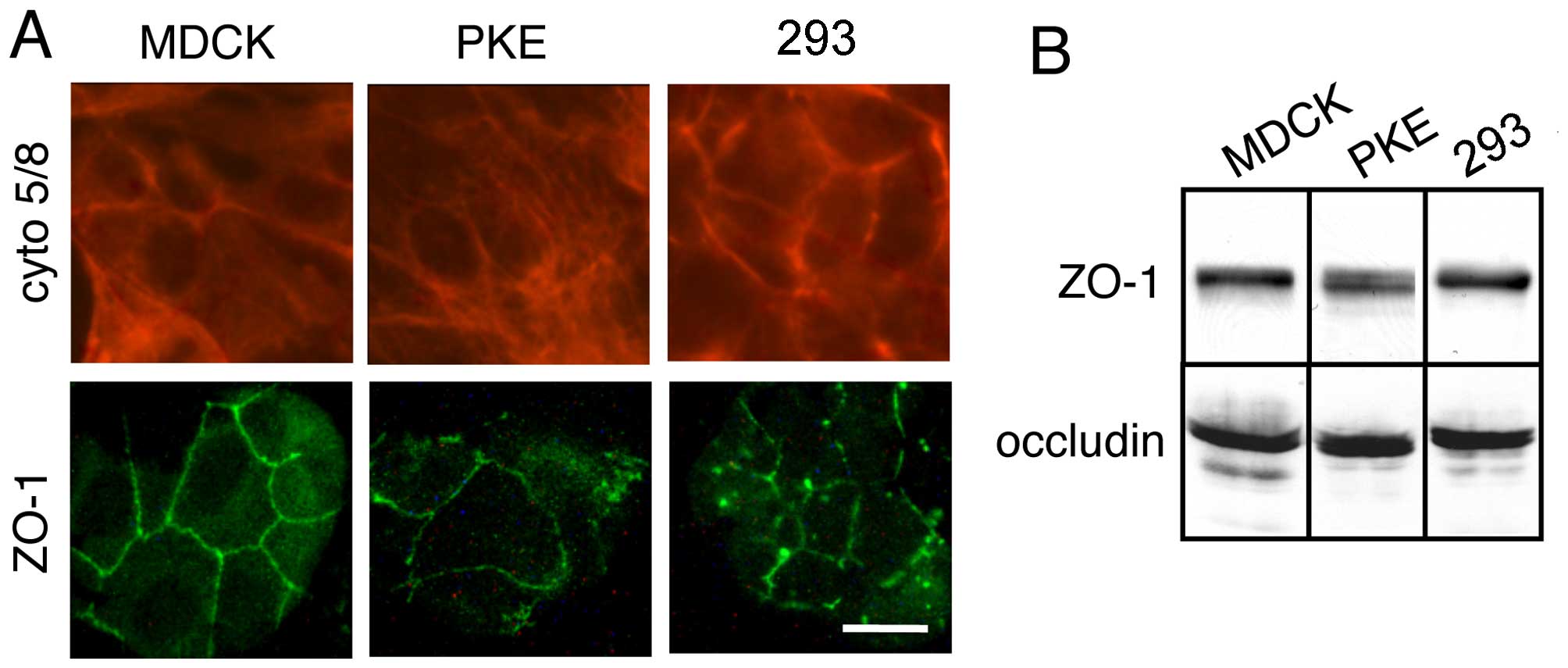|
1
|
Graham FL, Smiley J, Russell WC and Nairn
R: Characteristics of a human cell line transformed by DNA from
human adenovirus type 5. J Gen Virol. 36:59–74. 1977. View Article : Google Scholar : PubMed/NCBI
|
|
2
|
Louis N, Evelegh C and Graham FL: Cloning
and sequencing of the cellular-viral junctions from the human
adenovirus type 5 transformed 293 cell line. Virology. 233:423–429.
1997. View Article : Google Scholar : PubMed/NCBI
|
|
3
|
Suzuki R, Sakamoto H, Yasukawa H, Masuhara
M, Wakioka T, Sasaki A, Yuge K, Komiya S, Inoue A and Yoshimura A:
CIS3 and JAB have different regulatory roles in interleukin-6
mediated differentiation and STAT3 activation in M1 leukemia cells.
Oncogene. 17:2271–2278. 1998. View Article : Google Scholar : PubMed/NCBI
|
|
4
|
Shaw G, Morse S, Ararat M and Graham FL:
Preferential transformation of human neuronal cells by human
adenoviruses and the origin of HEK 293 cells. FASEB J. 16:869–871.
2002.PubMed/NCBI
|
|
5
|
Franke WW, Grund C and Achtstätter T:
Co-expression of cytokeratins and neurofilament proteins in a
permanent cell line: cultured rat PC12 cells combine neuronal and
epithelial features. J Cell Biol. 103:1933–1943. 1986. View Article : Google Scholar : PubMed/NCBI
|
|
6
|
Damjanov I, Clark RK and Andrews PW:
Cytoskeleton of human embryonal carcinoma cells. Cell Differ.
15:133–139. 1984. View Article : Google Scholar : PubMed/NCBI
|
|
7
|
Lee VM and Andrews PW: Differentiation of
NTERA-2 clonal human embryonal carcinoma cells into neurons
involves the induction of all three neurofilament proteins. J
Neurosci. 6:514–521. 1986.PubMed/NCBI
|
|
8
|
Schmidt U, Müller U, Metz KA and Leder LD:
Cytokeratin and neurofilament protein staining in Merkel cell
carcinoma of the small cell type and small cell carcinoma of the
lung. Am J Dermatopathol. 20:346–351. 1998. View Article : Google Scholar : PubMed/NCBI
|
|
9
|
Farquhar MG and Palade GE: Junctional
complexes in various epithelia. J Cell Biol. 17:375–412. 1963.
View Article : Google Scholar : PubMed/NCBI
|
|
10
|
Furuse M, Hirase T, Itoh M, Nagafuchi A,
Yonemura S and Tsukita S and Tsukita S: Occludin: a novel integral
membrane protein localizing at tight junctions. J Cell Biol.
123:1777–1788. 1993. View Article : Google Scholar : PubMed/NCBI
|
|
11
|
Furuse M, Fujita K, Hiiragi T, Fujimoto K
and Tsukita S: Claudin-1 and -2: novel integral membrane proteins
localizing at tight junctions with no sequence similarity to
occludin. J Cell Biol. 141:1539–1550. 1998. View Article : Google Scholar : PubMed/NCBI
|
|
12
|
Furuse M, Itoh M, Hirase T, Nagafuchi A,
Yonemura S and Tsukita S and Tsukita S: Direct association of
occludin with ZO-1 and its possible involvement in the localization
of occludin at tight junctions. J Cell Biol. 127:1617–1626. 1994.
View Article : Google Scholar : PubMed/NCBI
|
|
13
|
Itoh M, Furuse M, Morita K, Kubota K,
Saitou M and Tsukita S: Direct binding of three tight
junction-associated MAGUKs, ZO-1, ZO-2, and ZO-3, with the COOH
termini of claudins. J Cell Biol. 147:1351–1363. 1999. View Article : Google Scholar : PubMed/NCBI
|
|
14
|
Boller K, Vestweber D and Kemler R:
Cell-adhesion molecule uvomorulin is localized in the intermediate
junctions of adult intestinal epithelial cells. J Cell Biol.
100:327–332. 1985. View Article : Google Scholar : PubMed/NCBI
|
|
15
|
Ozawa M, Baribault H and Kemler R: The
cytoplasmic domain of the cell adhesion molecule uvomorulin
associates with three independent proteins structurally related in
different species. EMBO J. 8:1711–1717. 1989.PubMed/NCBI
|
|
16
|
Ozawa M, Ringwald M and Kemler R:
Uvomorulin-catenin complex formation is regulated by a specific
domain in the cytoplasmic region of the cell adhesion molecule.
Proc Natl Acad Sci USA. 87:4246–4250. 1990. View Article : Google Scholar : PubMed/NCBI
|
|
17
|
Aberle H, Butz S, Stappert J, Weissig H,
Kemler R and Hoschuetzky H: Assembly of the cadherin-catenin
complex in vitro with recombinant proteins. J Cell Sci.
107:3655–3663. 1994.PubMed/NCBI
|
|
18
|
Jou TS, Stewart DB, Stappert J, Nelson WJ
and Marrs JA: Genetic and biochemical dissection of protein
linkages in the cadherin-catenin complex. Proc Natl Acad Sci USA.
92:5067–5071. 1995. View Article : Google Scholar : PubMed/NCBI
|
|
19
|
Buxton RS and Magee AI: Structure and
interactions of desmosomal and other cadherins. Semin Cell Biol.
3:157–167. 1992. View Article : Google Scholar : PubMed/NCBI
|
|
20
|
Garrod DR, Merritt AJ and Nie Z:
Desmosomal cadherins. Curr Opin Cell Biol. 14:537–545. 2002.
View Article : Google Scholar : PubMed/NCBI
|
|
21
|
Nakanishi Y, Ogawa K, Yanagita K and
Yamauchi C: Body measurement and some characteristics of inbred
Clawn miniature pigs. Jpn J Swine Sci. 28:211–218. 1991. View Article : Google Scholar
|
|
22
|
Ozawa M: p120-independent modulation of
E-cadherin adhesion activity by the membrane-proximal region of the
cytoplasmic domain. J Biol Chem. 278:46014–46020. 2003. View Article : Google Scholar : PubMed/NCBI
|
|
23
|
Miyashita Y and Ozawa M: A dileucine motif
in its cytoplasmic domain directs beta-catenin-uncoupled E-cadherin
to the lysosome. J Cell Sci. 120:4395–4406. 2007. View Article : Google Scholar : PubMed/NCBI
|
|
24
|
Ozawa M and Kobayashi W: Cadherin
cytoplasmic domains inhibit the cell surface localization of
endogenous E-cadherin, blocking desmosome and tight junction
formation and inducing cell dissociation. PLoS One. 9:e1053132014.
View Article : Google Scholar : PubMed/NCBI
|
|
25
|
Kalluri R and Weinberg RA: The basics of
epithelial-mesenchymal transition. J Clin Invest. 119:1420–1428.
2009. View
Article : Google Scholar : PubMed/NCBI
|
|
26
|
Ohkubo T and Ozawa M: The transcription
factor Snail downregulates the tight junction components
independently of E-cadherin downregulation. J Cell Sci.
117:1675–1685. 2004. View Article : Google Scholar : PubMed/NCBI
|
|
27
|
Stewart DB, Barth AI and Nelson WJ:
Differential regulation of endogenous cadherin expression in
Madin-Darby canine kidney cells by cell-cell adhesion and
activation of beta-catenin signaling. J Biol Chem. 275:20707–20716.
2000. View Article : Google Scholar : PubMed/NCBI
|
|
28
|
Frank M, Ebert M, Shan W, Phillips GR,
Arndt K, Colman DR and Kemler R: Differential expression of
individual gamma-protocadherins during mouse brain development. Mol
Cell Neurosci. 29:603–616. 2005. View Article : Google Scholar : PubMed/NCBI
|
|
29
|
Fallaux FJ and Hoeben RC: Safety of
recombinant adenoviruses produced on adenovirus-transformed human
cells. Dev Biol (Basel). 106:489–497. 501–511. 2001.
|
|
30
|
Arnhold S, Post C, Glüer S, Hoopmann M,
Wenisch S, Volpers C and Addicks K: Neuronal characteristics of
amniotic fluid derived cells after adenoviral transformation. Cell
Biol Int. 32:1559–1566. 2008. View Article : Google Scholar : PubMed/NCBI
|
|
31
|
Lin YC, Boone M, Meuris L, Lemmens I, Van
Roy N, Soete A, Reumers J, Moisse M, Plaisance S, Drmanac R, et al:
Genome dynamics of the human embryonic kidney 293 lineage in
response to cell biology manipulations. Nat Commun. 5:47672014.
View Article : Google Scholar : PubMed/NCBI
|
|
32
|
Schäfer S, Koch PJ and Franke WW:
Identification of the ubiquitous human desmoglein, Dsg2, and the
expression catalogue of the desmoglein subfamily of desmosomal
cadherins. Exp Cell Res. 211:391–399. 1994. View Article : Google Scholar : PubMed/NCBI
|
|
33
|
Stevenson BR, Siliciano JD, Mooseker MS
and Goodenough DA: Identification of ZO-1: a high molecular weight
polypeptide associated with the tight junction (zonula occludens)
in a variety of epithelia. J Cell Biol. 103:755–766. 1986.
View Article : Google Scholar : PubMed/NCBI
|
|
34
|
Gumbiner B, Stevenson B and Grimaldi A:
The role of the cell adhesion molecule uvomorulin in the formation
and maintenance of the epithelial junctional complex. J Cell Biol.
107:1575–1587. 1988. View Article : Google Scholar : PubMed/NCBI
|
|
35
|
van Hengel J, Gohon L, Bruyneel E,
Vermeulen S, Cornelissen M, Mareel M and von Roy F: Protein kinase
C activation upregulates intercellular adhesion of
alpha-catenin-negative human colon cancer cell variants via
induction of desmosomes. J Cell Biol. 137:1103–1116. 1997.
View Article : Google Scholar : PubMed/NCBI
|
|
36
|
Taniguchi T, Miyazaki M, Miyashita Y,
Arima T and Ozawa M: Identification of regions of alpha-catenin
required for desmosome organization in epithelial cells. Int J Mol
Med. 16:1003–1008. 2005.PubMed/NCBI
|
|
37
|
Kan NG, Stemmler MP, Junghans D, Kanzler
B, de Vries WN, Dominis M and Kemler R: Gene replacement reveals a
specific role for E-cadherin in the formation of a functional
trophectoderm. Development. 134:31–41. 2007. View Article : Google Scholar
|
|
38
|
Fleming TP, Garrod DR and Elsmore AJ:
Desmosome biogenesis in the mouse preimplantation embryo.
Development. 112:527–539. 1991.PubMed/NCBI
|














